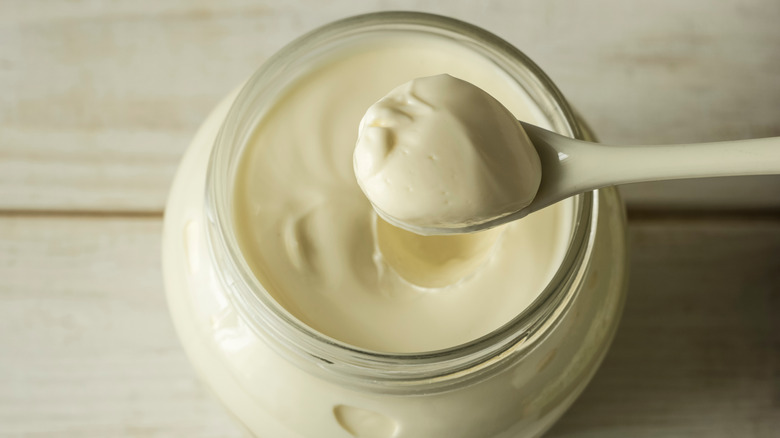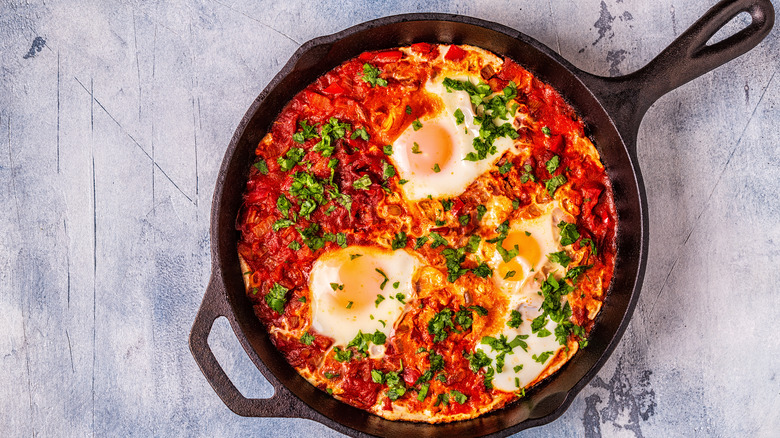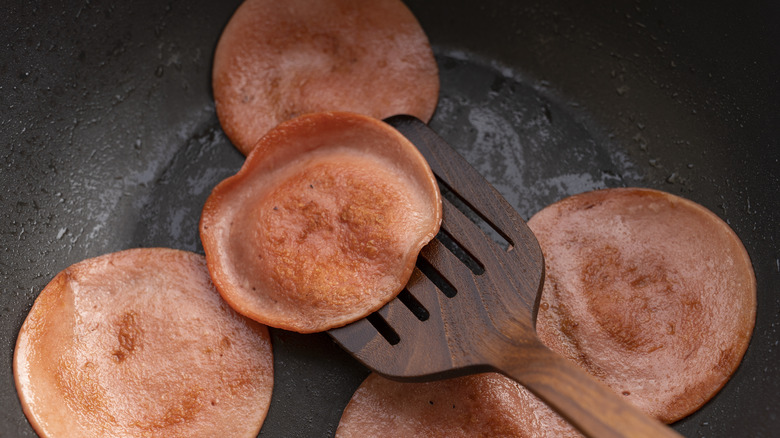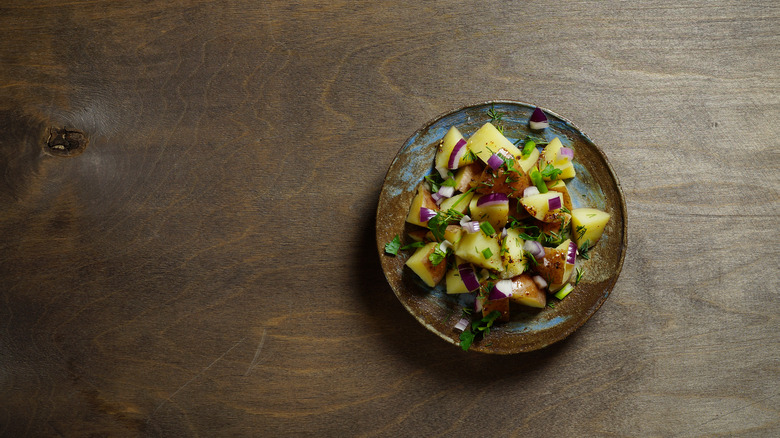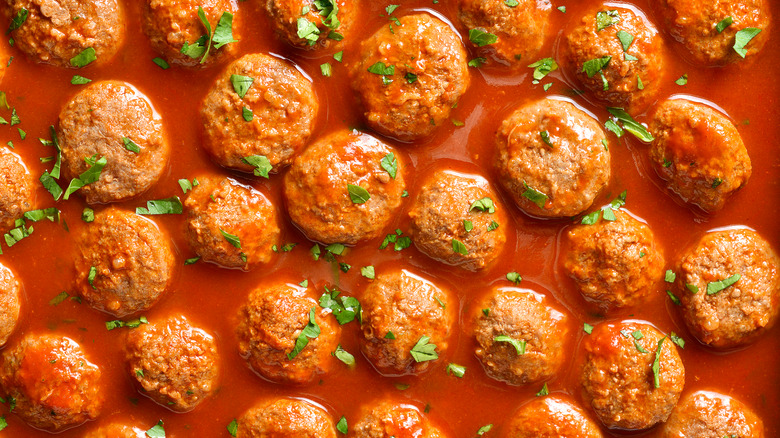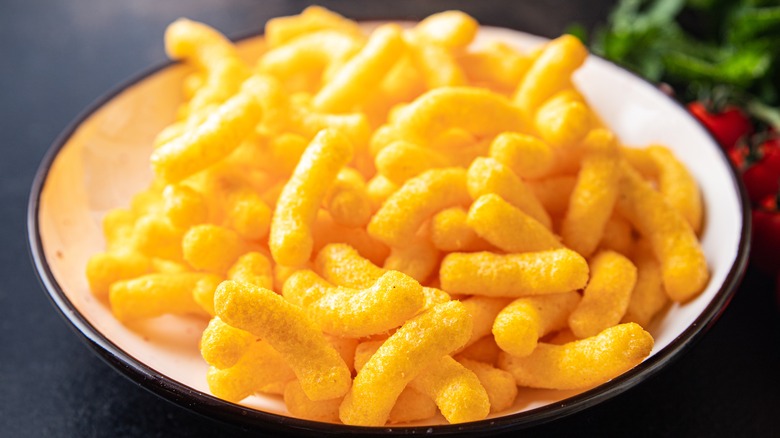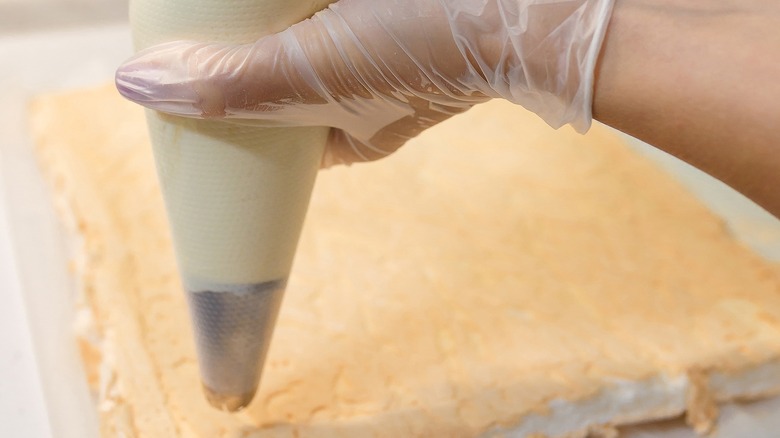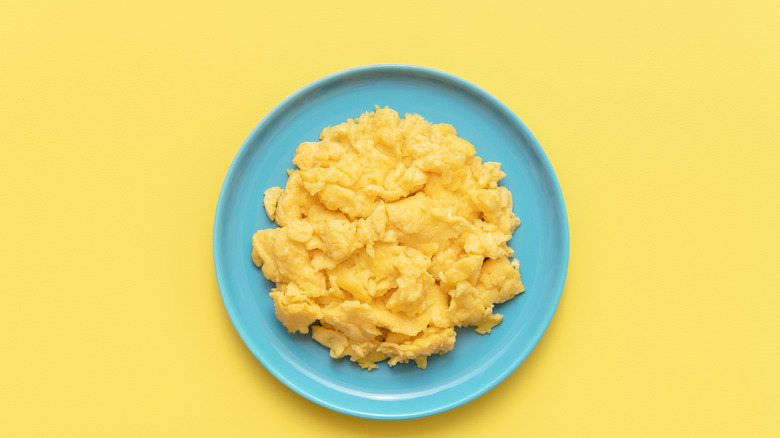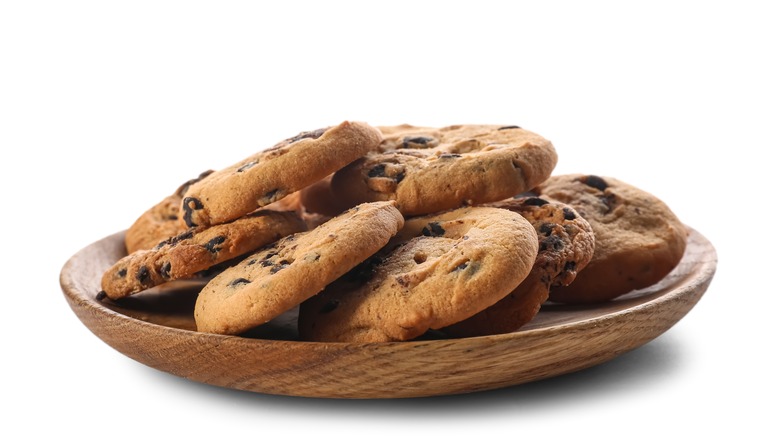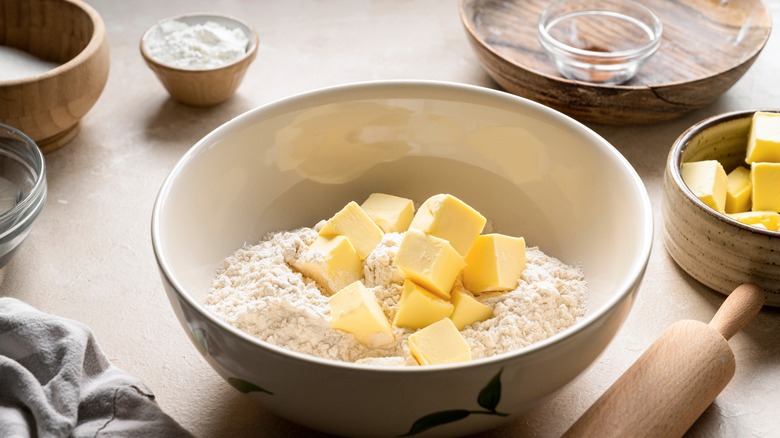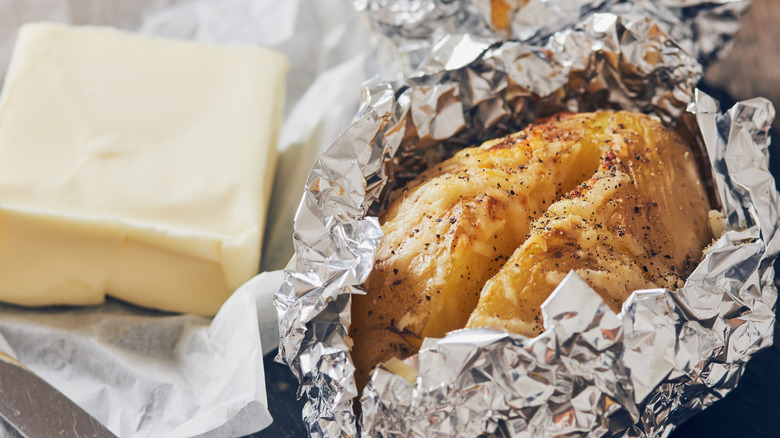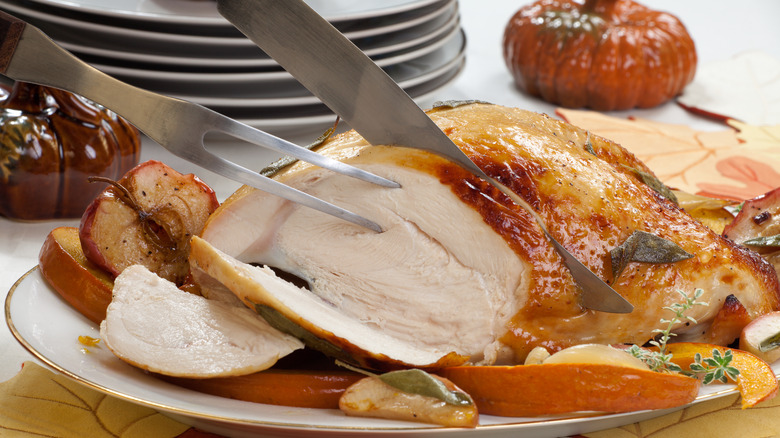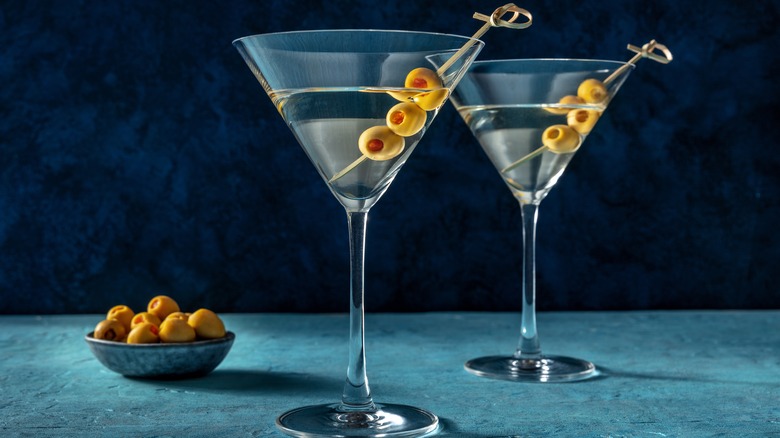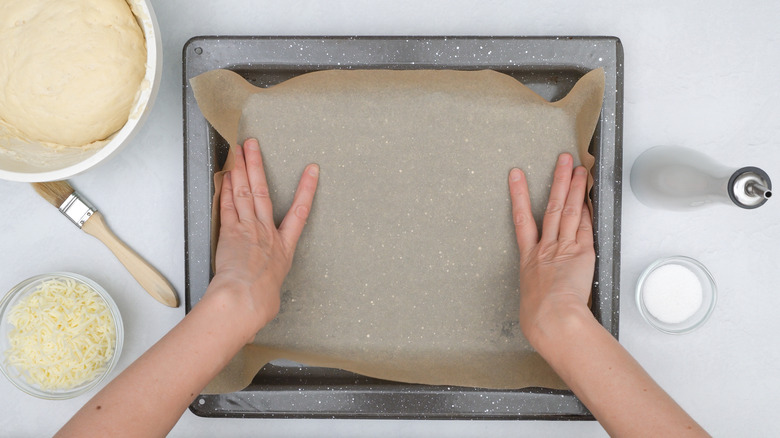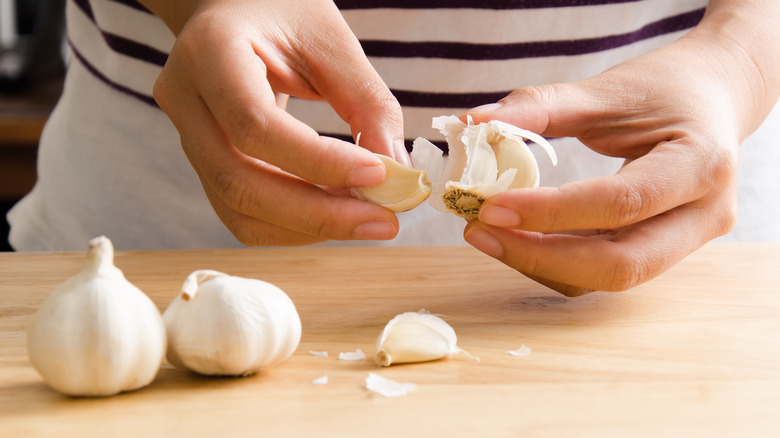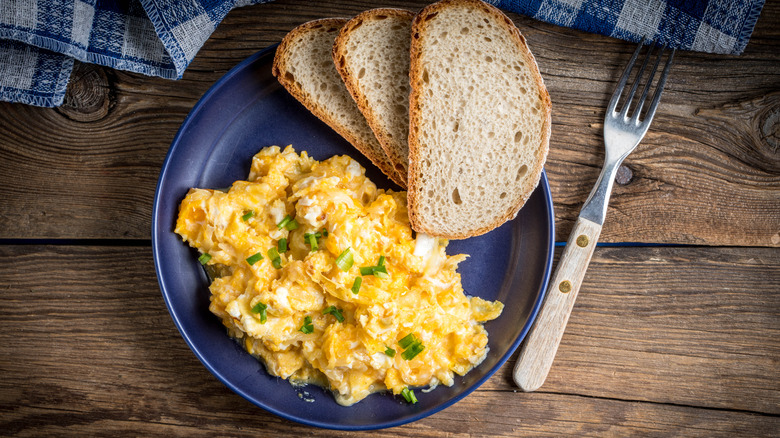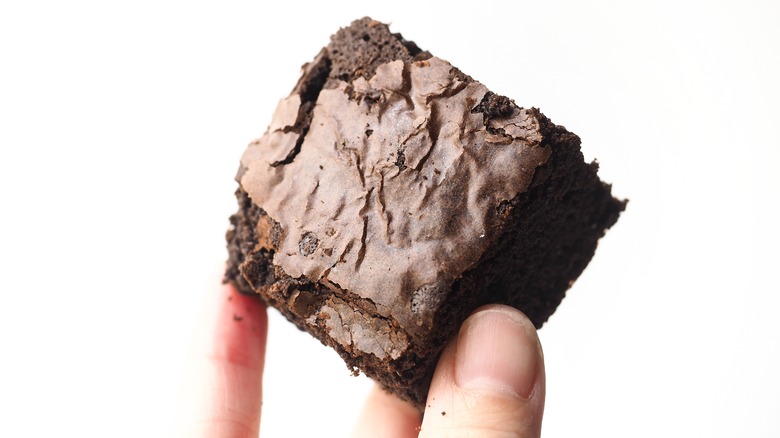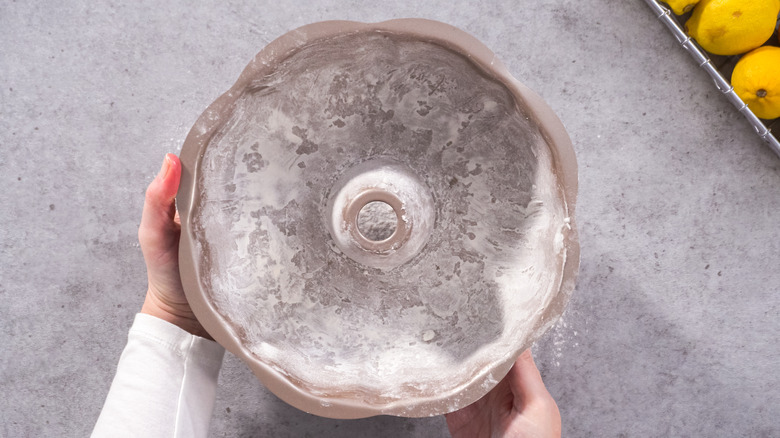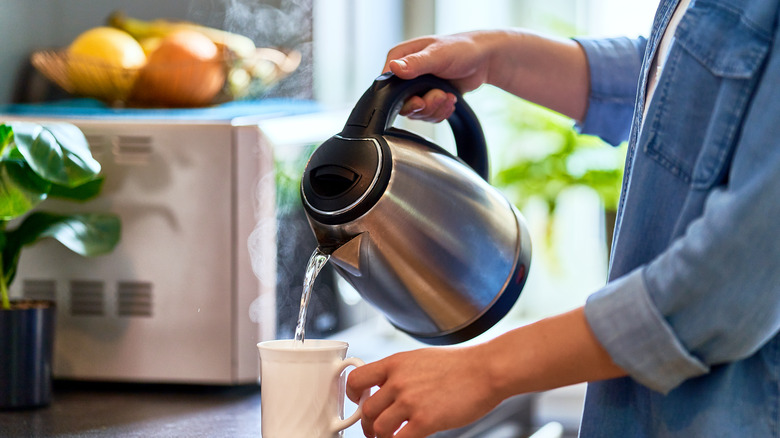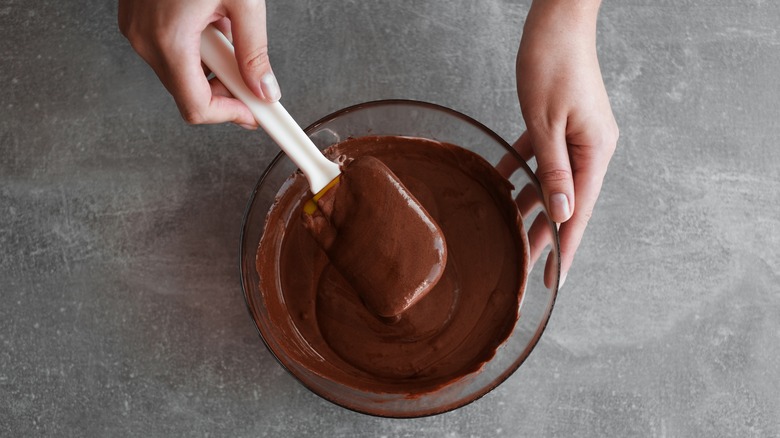Alton Brown's 20 Best Cooking Tips For Home Chefs
Alton Brown is no doubt one of the most recognized names in American food television. According to the Food Network, Brown began his career as a cameraman with close to eight years of experience directing television commercials before going into culinary school. Brown has been an important part of several Food Network shows, including as the host, writer, and show-writer of "Good Eats," and commentator on both "Iron Chef America" and "Cutthroat Kitchen." Besides also writing eight books on cooking, including "Alton Brown: EveryDayCook," and "I'm Just Here for the Food," Alton Brown received two James Beard awards in his career for Best TV Food Personality and Outstanding Television Host, (via Food Network).
Outside of all the accolades for his work in food media, Alton Brown is also a proficient cook who frequently shares his tips for making the lives of home chefs much easier. Here are some of the kitchen hacks Alton Brown has put out in recent years that make us all breathe a little easier when it comes to food.
Cooking steak in mayonnaise
While many folks would squirm at the site of the egg-based condiment, Alton Brown embraces it. Alton Brown, in an Instagram post in 2018, recommended cooking steak in mayonnaise in the absence of butter or oil. Not only does using mayonnaise impart a much-needed pop of acidity, but the fat-rich condiment contributes to the Maillard reaction — which amplifies the browning of the crust that is, in short, the very pinnacle of a good steak. The Los Angeles Times goes on to note that using mayonnaise is especially valuable with thin cuts of steak since the mayonnaise locks in the moisture that, if left to its own devices, would evaporate and result in a dry, tough strip steak. What a valuable tip!
Using canned tomatoes and eggs for an easy meal
Most home cooks can resonate with the feeling of not having anything in their kitchen to make dinner with. But with these two ingredients, Alton Brown shares that you can easily make a meal without the cost (and the fuss) of ordering out.
As Brown shared on his YouTube series Quarantine Quitchen, having eggs and canned tomatoes handy can transform the leftovers in your fridge into something truly remarkable. If you have leftover peppers and onions in your kitchen, you can add canned tomatoes and poached eggs to make traditional Israeli shakshuka. Or, go for Mexican huevos rancheros with canned black beans, assorted veggies, and spices. Both eggs and canned tomatoes are budget-friendly vegetarian ingredients that tend to keep well in your cabinet, countertop (for unwashed eggs), or in your fridge.
Frying bologna for an ingenious sandwich
There are a million ways to make a sandwich, but there are very few that make an absolutely delicious one. Alton Brown has a high standard for sandwiches, as noted by his tweet, which describes a sandwich as "any food designed to be conveyed to the mouth by fingers whereby the food and fingers are separated by leavened bread which directly juxtaposes at least two sides of the filling and is consumed along with the filling." Sorry open-faced sandwiches, but Alton Brown doesn't believe you deserve the honorable designation of a proper sandwich.
Alton Brown makes his perfect sandwich with the addition of both cold and fried bologna. Fried bologna, Alton notes on an episode of Quarantine Quitchen, is a Southern staple that adds a unique texture and flavor to the cold bologna in the sandwich. Alton Brown layers the cold and the pan-fried bologna together with mustard on one side of the bread and mayonnaise on the other (it's clear that he loves mayonnaise).
Pairing sumac with starches
Besides mayonnaise, Alton Brown also has a deep appreciation for sumac. Sumac is native to the warm humid areas of both Africa and North America. Sumac berries are collected, dried, and then sold in the spice section of most grocery stores. The taste of the spice has a subtle brightness and tartness — due to the presence of malic acid on the surface of the berry. Sumac has a similar flavor to citrus, which Alton notes are the perfect pairing for starchy foods like beans and potatoes.
Brown notes that sumac is his "hidden weapon" in his book "The Everyday Cook." He writes, "Earthy yet lemony, unique yet oddly familiar, sumac is also a key ingredient in za'atar, which is kind of like the five spices of the Middle East. I tend to use it a lot on fried foods that can use some acidity to cut oiliness." But, your roasted potatoes would benefit from the bright lemony flavor of the sumac berry just as much as your french fries.
Using a mini muffin tray for perfect meatballs
In an episode of "Good Eats," Alton Brown notes that he uses his oven to cook meatballs from start to finish — rather than the traditional method of baking the meatballs before submerging the meatballs in a sauce to finish cooking. The oven-only method allows the meatballs to cook at a sustained temperature, meaning that the meat will cook completely and thoroughly in every single meatball. And with the handy use of using a mini muffin tin, you won't have to worry about flipping your meatballs constantly to ensure all sides cook evenly.
The downside of using a mini-muffin tin to cook meatballs is that you won't be able to recreate the iconic sear on the exterior of the meatballs. But of course, Alton Brown has a tip for this too. He coats his meatballs individually in breadcrumbs before placing the balls in the tin for a crispy texture.
DIY-ing cheese dust flavoring
What do popular, puffed savory snacks like Cheetos and Nacho Cheese Doritos have in common? A delicious, finger-licking coat of cheese dust, of course! Alton Brown shares the same facilitation with this snacking experience essential. In fact, the leftover dust at the end of a bag of Cheetos is "the best flavor on Earth," Brown shares in a blog post.
In his recipe for homemade cheese dust, Brown combines powdered cheddar cheese, powdered parmesan cheese, nutritional yeast, buttermilk powder, and Kosher salt. He recommends sprinkling this savory mixture over popcorn, but you can also use homemade cheese dust for seasoning homemade tortilla chips or potato chips. Or, if you want to enjoy the flavors of Cheetos without all the work, you can check out a Cheetos Duster from Amazon that will do all the work for you. It's like a NutriBullet for Cheetos — and we're here for it.
Learning how to make pastry cream
If you are a novel home cook looking to build skills and master the art of advanced pastry and baking skills, Alton Brown recommends starting with the basics. On his website, Brown claims pastry cream is "one of the great mother sauces of the dessert world" and should be mastered by every home cook. The recipe for pastry cream, otherwise known as crème pâtissière, includes a milk base with cornstarch, sugar, butter, vanilla, and eggs, which makes a more stable filling than crème anglaise. Pastry cream is used to fill desserts like Boston cream pie, cream puffs, or eclairs. Pastry cream can also be flavored with dark chocolate and fill your favorite pastries.
While you're probably not rushing out to make cream puffs on your first day in the kitchen, Brown notes that pastry cream is the foundation for more complex desserts. So, you'll have to master it eventually.
Adding mayonnaise to scrambled eggs
What is it with Alton Brown and mayonnaise? In a segment on "The Late Show with Stephen Colbert," entitled "Precise Advice with Alton Brown," the T.V. personality notes that adding mayonnaise to scrambled eggs seems a bit out there, but works well with the emulsion qualities of scrambled eggs. Both scrambled eggs and mayonnaise are considered emulsions — homogenous mixtures of fat and water. Mayonnaise acts as a bolster that increases the fat content and smoothes out the flavor of the eggs. Plus, the base of mayonnaise is just eggs, oil, and an acid like vinegar or lemon juice.
If you are a little weary of adding a spoonful of goopy mayonnaise to your scrambled eggs, you have other options to boost the flavor and texture of your favorite breakfast food. You can add a bit of heavy cream or sour cream for a depth of flavor. You can also add a splash of plain, unflavored seltzer water for more aeration in your scrambled eggs.
Swapping in bread flour in chocolate chip cookies
You have a lot of potentials to modify chocolate chip cookie recipes — like using chocolate chunks instead of chocolate chips or adding a layer of flaked sea salt for a deflection from the sweetness of the cookie. But what about changing the type of flour you use?
One of Alton Brown's best food hacks is to exchange bread flour for all-purpose flour. The bread flour, because of its marginally higher protein content, produced a cookie with more chew than a standard chocolate chip cookie (via Alton Brown). Along with this major change in the traditional cookie recipe, Brown swaps one of the egg whites for milk and alters the ratio of brown sugar to white sugar. Brown sugar and milk both have a bit more moisture than the ingredients Brown substitutes them for, meaning that these cookies come out extra chewy. All you'll need is a glass of milk to pair with your delicious homemade cookies.
Investing in expensive butter for baking
In his "Precise Advice" segment, Alton Brown notes that investing in more expensive butter brands is more advantageous than its cheaper counterparts, noting that cheaper generic brands can contain close to 12% more moisture than more expensive, name-brand butter. But less moisture isn't always better, especially for baked goods that use the steam in the butter to aid in rising — like croissants.
Expensive European butter contains a butterfat content of around 82% to 86%, while AA butter contains around 80% butterfat. Lower butterfat can be beneficial for muffins and muffins in both preserving the texture and the moisture of the baked good. The more expensive butter should be deferred to when you want a strong buttery flavor. Brioche bread or high-quality pastries benefit from the buttery undertones of more expensive butter. If you want to splurge on your butter, our favorite brands include the Vermont Creamery — it is almost half the price as other top-performing butter brands, but still has an excellent flavor.
Skipping the foil for baked potatoes
Foil and mashed potatoes seem to go hand-in-hand (and hopefully, in your hands too). But do you always need aluminum foil to make a perfectly soft baked potato?
Alton Brown disagrees. His preferred method for making baked potatoes ditches the foil for a bit of oil, and salt, and then poke it with a fork. Pricking the potato with a fork is an essential step to release the steam from your potatoes as the 'tater cooks. He also swears by coating the potato in a thick layer of oil before cooking for maximum crispiness. The oil also gets much hotter than the potato itself, which locks in the moisture of the potato.
Another bonus of using this method for baking potatoes is that you can place the potato straight onto your oven rack — no need to put it on a baking sheet and dirty another pan. The exact baking time will depend on the size of the potato, but Brown notes that you can give the potato a squeeze to see how much give it has to determine if it is done or not.
Keeping it simple while carving turkey
Thanksgiving, Easter, and Christmas may be the three times a year you pull out an electric carving knife to cut through turkey or ham. Alton Brown would prefer we keep it simple. On his YouTube channel, he claims to only like using spring-loaded tongs and an "honest-to-goodness" carving knife. Among these kitchen tools, you should also keep a sturdy cutting board and a towel for stabilizing the meat handy. The tongs are used for a stabilizing grip on the turkey while the sharpened cutting knife easily slices through the meat with ease.
Alton Brown is full of other Thanksgiving tips as well, including the part about skipping basting the turkey. He told NPR that basting the turkey only prolongs the cooking time because you open and close the oven frequently — and it doesn't actually keep the meat moist. Instead, Brown recommends wet brining or dry curing the turkey to optimize moisture.
Using vodka for a dirty martini
Although it's a bit boozier than Alton Brown's other cooking hacks, every home cook should also know how to pair and make a cocktail like a basic dirty martini. This cocktail usually uses gin (Alton Brown recommends his favorite Beef Eater Gin, per a tweet), vermouth, olive brine, and olives. But Brown makes an important substitute — instead of using gin, he opts for vodka. In an episode of "Quarantine Quitchen," Brown uses vodka for a less potent alcoholic flavor.
Brown is also making waves in the traditional dirty martini recipe by making an olive brine of his own. The chef uses a blender to mix olives, olive brine, an anchovy sliver, salt, and hot sauce to make a green concoction that Brown deems "a longer-lasting brine." While this brine might sound delicious for an experienced and adventurous mixologist, we might just stick to the classic dirty martini ourselves.
Using water on parchment to combat stickiness
If you're baking anything at home, you need to use a liner for your baking pan. The two primary options are parchment paper and silicon mats. While silicon mats are heavier and can stick to the pan a little easier than parchment paper, silicon mats can create too much of a cushion between the hot pan and whatever you're baking, resulting in a less-than-perfect golden brown color. Parchment paper is a bit more ubiquitous because it is thinner and can be cut based on the size you need. But there's one problem with parchment — it doesn't stay still.
Alton Brown has a tip for anyone who has been inordinately frustrated with parchment paper that curls back every time it's placed on a baking tray. To encourage the paper to stay put, Alton Brown recommends spraying the baking pan with water before placing the parchment down to help it stay put.
Peeling garlic with your fingers
Chef Alton Brown frequents garlic in his episodes of Quarantine Quitchen, as any good chef should, and uses a relatively simple way to peel his garlic. Instead of breaking out yet another kitchen gadget to peel the papery skin off the garlic cloves, Brown keeps it simple by running his fingers over the skin to lift it from the clove. This method of removing garlic skin is not only quick, but it will leave an aromatic residue of garlic all over your hands and your kitchen.
If you're not a fan of the smell of garlic (to which, we ask why), you can remove the smell from your fingers after you finish peeling the garlic by mixing 1 teaspoon of salt with 2 teaspoons of baking soda with enough water to make a paste. Schmear the paste on your hands for about 30 seconds before rinsing and washing again with soap and water.
Serving scrambled eggs on a warm plate
Nothing is worse than cold and hard scrambled eggs. While you can fix hard scrambled eggs into soft scrambled eggs by cooking low and slow, adding cream, making the eggs in a small saucepan, and removing the eggs sooner than you'd think you need to, you have to be more diligent about keeping up the heat of the plate to prevent your eggs from going cold.
Alton Brown recommends serving scrambled eggs on a warm plate to optimize the warmth of your eggs. You can either place an oven-safe plate in your traditional or toaster oven to stay warm. Nigella Lawson recommends instead soaking your plates in water for at least five minutes before drying and serving your eggs. The warm plate will keep the bottom of the scrambled eggs warm and delicious — but we still recommend eating your eggs soon after you finish cooking the eggs.
Twice baking brownies for better texture
The best parts about a brownie are the crackled layer on top and the crispy edges. Brown has it figured out with his method for making brownies. For a better brownie crust, Brown recommends baking the brownies twice. Bake the brownies for the first 15 minutes at the temperature denoted in the recipe. Then, pull the brownies out of the oven and allow the dessert to cool for 15 minutes. Then, resume baking until your brownies have an internal temperature of 195 F. The exact time it will take for your brownies to get to that internal recipe will depend on the recipe you use; using about 20 minutes as a proxy for most standard brownie recipes is a good idea.
Alton Brown also recommends using a hefty dose of cocoa powder in the brownie recipe to maximize chocolate flavor, but this will all depend on your flavor preferences.
Plastic wrapping bundt pans for mess-free coating
There might not be a more disappointing feeling than watching your bundt cake come out of the oven with a piece of cake stuck to the pan. The reason why your cake is sticking is that you didn't grease every nook and cranny of the pan. Luckily, you can make a "cake goop" with equal parts oil, flour, and shortening as a liner for your bundt pan.
But despite this simple tool, there is some technique needed to ensure that your entire pan is ready to bake. Brown's method (via Facebook) of lining a bundt pan involves coating the bundt pan with melted butter before sprinkling 2 tablespoons of flour or granulated sugar. Then, Brown covers the pan with a layer of plastic wrap and shakes until the entire pan is covered. Then, the plastic wrap can be removed, and the remainder of the flour or sugar into the trash.
Consulting an electric kettle for quick rice
One of the detriments of making rice is the amount of time it takes for the perfect, fluffy texture. Per a YouTube video entitled "Pantry Raid: Rice Edition," Alton uses a somewhat unconventional kitchen tool to help make fluffy rice fast. Brown starts cooking the rice on the stove with a bit of fat (for flavor, of course) and salt. He then pours in hot water from an electric kettle, covers the rice, and lets it set for about 20 minutes.
This way of cooking rice is called the pilaf method and allows the chef to control how much water is used in the recipe. Controlling the water added to the rice is an especially important step to control the moisture content of whatever rice type you're working with — whether it be brown, jasmine, or basmati. Before firing up your kettle, you should note how much water your rice type requires.
Making a simple mousse with chocolate and eggs
Chocolate mousse is a delicious dessert that Alton Brown believes can be made with the addition of just two ingredients. He sticks to melting your chocolate of choice over a double broiler until melted. The other ingredient is separated yolks and whites — the yolks being added first to create a soft decadent custard, and the egg whites being added next to add protein and structure to your mousse. Equally as important, Brown advocates chilling your mousse for several hours until the mixture is stable and ready to be served.
Chocolate mousse is deliciously easy to make and is super fluffy — which is why it should be in any home cook's recipe arsenal. You can add a layer of this mousse to the cake or serve it in (per Brown's recommendation) a Champagne glass with fresh berries and a bit of whipped cream.

